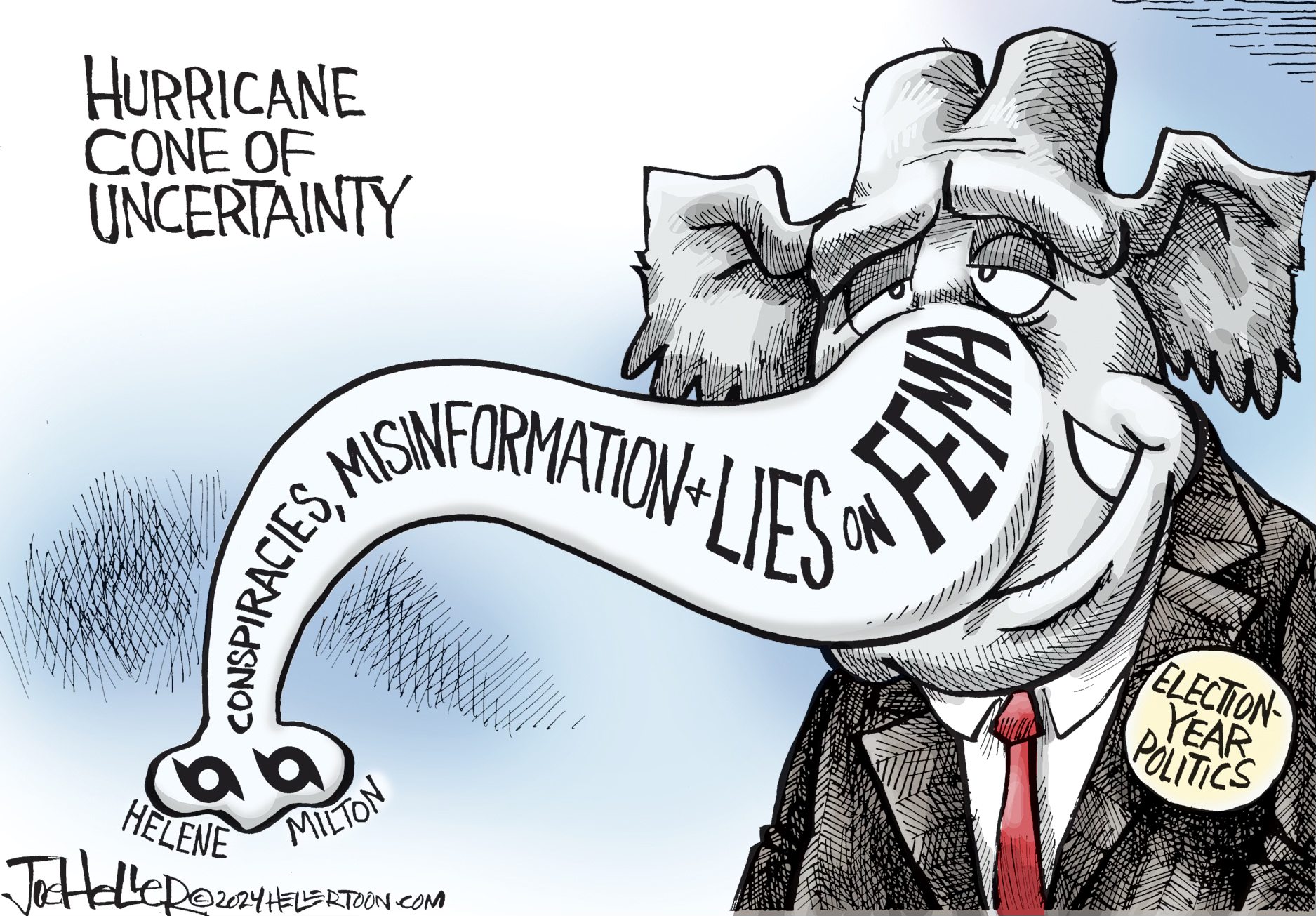The Daily Escape:

One of November’s big uncertainties will be how the two hurricanes are going to impact voting in the southeast. We know that the North Carolina’s Electoral Vote was clearly in play before Helene washed away the western part of the state, but has the devastating flooding changed that picture?
Democrats’ hopes to see North Carolina go Blue could turn on who has access to voting in the west part of the state and on which voters can or can’t access voting by Nov. 5
Time Magazine quotes Jason Roberts, a political science professor at the University of North Carolina, Chapel Hill: (emphasis by Wrongo)
“It’s going to be…difficult for people to vote…And, quite frankly, given the challenges these people are facing, voting is probably going to be much farther down on the list of priorities than it otherwise would be.”
Local officials fear that the aftermath of Helene could reduce voter turnout, disrupt ballot delivery, or hamper accurate polling, all of this in a state where the margin of victory was going to be slim under ideal conditions.
Tom Sullivan, a blogger who lives in Asheville, NC, observed:
“Hurricane Helene has upset many residents’ fall plans in western North Carolina, among which are plans for early voting set to begin on October 17. Gov. Roy Cooper (D) is urging the annual migration of fall “leaf peepers” to stay home and away from the disaster area. Local businesses who count on that trade may not have beds or power or water for them anyway. Hotels are filled with relief workers or people whose homes are unlivable or gone.
More:
“Local election boards will have to alter election plans that under normal circumstances are unalterable once submitted and approved by the state’s Board of Elections in August.”
The indispensable Democracy Docket reports that:
“State officials passed emergency measures on Monday to make it easier for disaster victims to cast their ballots….The bipartisan North Carolina State Board of Elections unanimously approved changes in 13 counties where infrastructure, access to polling places, and postal services are likely to continue to be disrupted through the election, the board’s Executive Director Karen Brinson Bell said in a press conference. Some of the changes include allowing county boards of elections to change early voting and Election Day voting locations with a bipartisan majority vote, recruiting more poll workers, and allowing voters to drop off their completed absentee ballots at any county board of elections office by 7:30 p.m. on Election Day.”
Sullivan says that only two of those 13 are “Blue counties” (Buncombe and Watauga). The rest are pretty solidly Red, and their combined populations are over 100,000 more than the Blues:
”Fourteen early voting sites were planned in Buncombe County. How many remain in operational condition and accessible after the flooding is under review. Some of the 80 Election Day precincts may have to be moved or combined. Giving advance notice to voters (given that informational literature is already printed) will prove a challenge, but there are still weeks to tackle that problem. Buncombe’s local Board will meet today to draft Plan B.”
More from Sullivan:
“What’s not clear is what happens in other counties. Watauga (which saw extensive flooding) planned for five EV sites. The rest of the 13 have two EV sites at best.”
From Karen Brinson Bell, Executive Director of the NC State Board of Elections:
“This disaster is not just affecting how we conduct elections; it’s affecting day-to-day life, and many of these communities will be without power, without water, without internet, without cell service, potentially for weeks,….Our job is to figure out, as long as there are citizens in those communities, how do we provide them with voting opportunities so that they can exercise their right to vote?”
Despite Helene, the state’s voter registration deadline is still Oct. 11 and early voting will still start on Oct. 17, as planned. And Bell said all 100 of the state’s county boards of elections are now open to the public. But the storm may have destroyed some polling places, or the locations may be inaccessible because of damaged infrastructure.
There were 40 early voting sites scheduled to be set up in the 13 counties that will be affected by the emergency measures approved by the North Carolina State Board of Elections. However, it’s not yet clear how many of those locations will be able to operate as voting sites.
Add to that, some citizens may have lost identification documents in the storm, which could add further difficulties to voting.
Professor Roberts said the measures that the North Carolina State Board of Elections passed still may not be enough, that the damage caused by Helene could reduce voter turnout in a state that has had very tight races in recent elections. Mail-in ballots may be particularly affected as the storm has badly disrupted the US Postal Service’s operations in parts of North Carolina. This could prevent people from receiving their mail-in ballots.
Meanwhile it’s difficult to assess who’s winning. The lack of electricity, cell service, and internet access is affecting pollsters’ ability to get accurate data.
The same is true about disinformation spread by Republicans.
Bell urged people to turn to reliable sources for information as they figure out a voting plan for November:
“I want to make sure that these people are safe from the storm…and able…to vote through this.”
Sullivan points out that some of the 80 Election Day precincts may have to be moved or combined. Giving accurate advance notice to voters will prove a challenge, but there is a little time left to tackle that problem.
